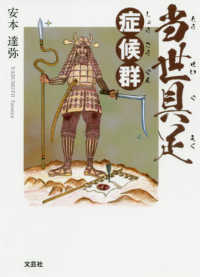Full Description
Applicative constructions are a distinctive grammatical feature of the Austronesian languages of western Indonesia, Malaysia, Singapore, and Brunei. Applicatives in these languages show varied syntactic and semantic properties, and are closely connected to causativization, aspectual meanings, and symmetrical voice. As a result, they do not fit neatly into 'canonincal' patterns for applicatives. This book adopts a construction-based, typologically-grounded approach, treating applicatives as pairings of form and meaning. Data from 85 languages is analyzed systematically, combining careful description with quantitative methods and extensive use of geomapping to explore the diverse properties of applicatives in this region and their diachronic development.
Contents
Acknowledgments
List of Figures and Maps
List of Tables
Abbreviations
1 Introduction
11 What are Applicatives?
12 Why Study Applicatives in Languages of West Nusantara?
13 Background and Sources of Data
14 Scope of the Study
15 Previous Research on Applicatives in West Nusantara Languages
16 Framework and Assumptions
17 Content and Structure
2 Case Study: Sundanese Applicatives
21 The Sundanese Language and Community
22 Basic Morphosyntax
23 Overview of Applicative Morphology
24 Locative-selecting Constructions Marked with ‑an
25 Theme- and Instrument-selecting Constructions Marked with ‑keun
26 Beneficiary-selecting Constructions Marked with pang‑ ‑keun
27 Beneficiary-selecting Constructions Marked with ‑keun
28 Other Applicative Constructions
29 Other AM-marked Constructions
210 Summary and Discussion
3 Towards a Typologically-grounded, Constructional Approach to Applicatives
31 What are Applicatives?
32 Problematic Constructions and Their Significance
33 Constructional Approaches as a Lens for West Nusantara Applicative Systems
34 On the Problem of Philippine-type Voice in a Study of Applicatives
35 On the Relationship between Serial Verb Constructions and Applicatives
36 West Nusantara Applicatives in Typological Perspective
4 The Distribution of Applicatives in West Nusantara Languages: A Bird's Eye View
41 Establishing the Basic Distribution
42 Properties Considered in the Survey
43 Overview of Results and Multivariable Analysis
44 Detailed Results for Structural Properties
45 Location and Genetic Affiliation
46 Summary and Implications
5 Interpreting Distributional Patterns through Geographic Typology
51 Sumatra and the Barrier Islands
52 Java and Madura
53 The Lesser Sundas
54 Mainland Southeast Asia and Peninsular Malaysia
55 Borneo and the Southern Philippines
56 Sulawesi
57 Summary of Major Findings
6 Properties of Applicative Constructions and their Distribution in West Nusantara
61 Distribution of Function and Form
62 Properties of ACs and AMs Considered in the Survey
63 Forms Marking Pivot-selecting Constructions
64 Forms Marking Pivot-neutral Constructions
65 Polyfunctionality of West Nusantara Applicative Morphemes
66 Comparative and Other Degree Constructions
67 Syntactic Properties of Applicative Constructions
68 Summary of Findings and Implications
7 A Functional Typology of Applicative Constructions in Languages of West Nusantara
71 Introduction
72 Sampling of Languages
73 Basic Morphosyntax
74 Applicative Morphology
75 Beneficiaries and Recipients
76 Instruments and Themes
77 Goals and locations
78 Circumstantial and Comitative Roles
79 Other Applied Phrases
710 Aspect, Intensity and Other Semantic Effects
711 Causative AM-marked Constructions
712 Applicatives and Voice
713 Summary of Findings
8 Conclusion
Appendix 1: Language Sample for Typological Survey
Appendix 2: Questionnaires Used in the Typological Survey
Appendix 3: Database for Typological Survey
References
Index







